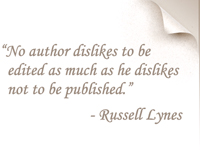When people learn that I am a writer and editor, they’ll often ask me to “look over” something they’ve written. Right away, a warning flag goes up for me because there are so many ways that I can look at a piece of writing, and if the author doesn’t know enough to say, “It just needs some copyediting” or “I wonder if the tone I’ve used is effective,” then I know that I’ll probably be faced with a manuscript with multiple levels of errors and issues.
Although there is no single “ideal” version of any piece of writing, there is a broad range of strategies and options for improving a text. It helps to know all the ways that an editor can respond to a draft, because a good editor will see the full range of possibilities–even if the author doesn’t.
So here’s how I look at what a piece of writing might need:
Level 1: Light Copyediting/Proofreading
At this level, the author is satisfied with the text and only wants minor and glaring errors in spelling, grammar, and punctuation cleaned up.
Level 2: Medium Copyediting
This level includes Level 1, plus it addresses issues of consistency and correctness for some of the finer details. Are numbers and abbreviations used consistently, are word choices appropriate to the audience, and are structural formatting (headings, etc.) consistent and logical?
Level 3: Stylistic Editing
At Level 3, the editor begins addressing the writer’s style. This includes issues such as wordiness, over-use of certain words or phrases, lack of transitional phrases (which highlight the piece’s organizational structure), appropriateness of tone, and even sentence rhythm (are all the sentences the same length?). If the piece is to be published, the publisher may have its own “style manual” or expected style, which can affect length of sentences, formality of tone, even formality of punctuation.
Level 4: Structural Editing
A major shift takes place at Level 4, because the editor begins to think about the piece beyond the sentence level. At level 4, an editor may begin to focus on internal paragraph structures (are ideas fully and logically explained?), paragraph organization (too many, too few, are transitions adequately marked?), order of information, and type and structure of headings (which includes how things look in the table of contents, if there is one). However, at this level, the editor is still working with what exists on the page, and doesn’t address larger issues that require rewriting.
Level 5: Substantive Editing
Level 5 moves beyond working with what the author has provided on the page, and begins to ask about the context for a piece of writing:
- who is the audience?
- what is the purpose of the piece?
- where will it be published?
- what does the author intend to accomplish with the piece (which may be different from its obvious purpose)?
At level 5, an editor may say, you need more details here, or this introduction requires an illustration or example, or even, your approach may not be appropriate for this audience. At Level 5, either the editor or the author may need to do some minor rewriting, even adding a little more content to what already exists.
Level 6: Revision Editing
When a piece needs revision, then other kinds of editing end (because it doesn’t make sense to edit or proofread until a new version is complete). As an editor responding to a piece that needs revision, I usually prepare a list of questions, combined with a critique of what works and doesn’t work in the piece as a whole. “Re-vision” means “re-seeing,” and that means that the author needs to go back and reconsider decisions that were made in the original draft. It may require redefining one’s audience or purpose, changing the structure of the piece, or substantively reworking the (mainly existing) content of the piece.
Level 7: Rewriting
At this level, an editor’s job shifts from changing what the author wrote, to writing it over again for them. This might mean changing the style, tone, structure, and even a substantive portion of the content. It might require returning to original source materials and conducting new research. In any case, this is no longer an attempt to fix the author’s work, but to start over with it (or portions of it).
As you can see, if someone hands me a piece that they think needs a Level 1 or 2 edit, and I return it with comments for a Level 6 edit (or suggest that they let me rewrite it for them (Level 7), then the author may come away feeling hurt or angry. It can work in reverse, also, where someone wants me to make the piece work–no matter how much change might be involved–but I understand from what they described that they simply want me to “clean it up.” Sometimes, of course, they don’t know what their piece needs, and asking me to look at it is their first attempt to get some outside feedback.
Whatever the case, having some precise way to discuss what a piece may need (and, not to mention, what editing that piece may cost), is a useful thing for both editor and author.
{ 4 comments }

